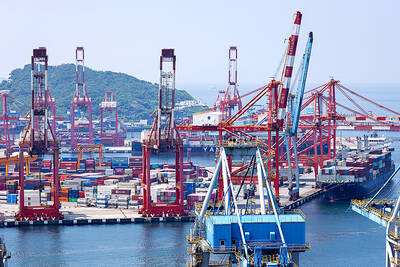The unemployment rate last month was unchanged at 4.18 percent from the previous month, maintaining the lowest level since August 2008, as stronger demand from the service sector offset weakness in the manufacturing industry, the Directorate-General of Budget, Accounting and Statistics (DGBAS) said yesterday.
On an annual basis, the unemployment rate was 0.46 percentage points lower than the 4.64 percent posted in January last year, the directorate said in a statement.
The seasonally adjusted unemployment rate, a more accurate indicator of the long-term trend, dropped a slight 0.02 percentage points from the previous month to 4.19 percent last month, the statement said.
“The labor market has remained stable, as reflected by the unemployment rate over the past few months,” Chen Min (陳憫), a deputy director at the statistics agency, told a press conference.
The total number of unemployed increased by a marginal 1,000 last month from December to 472,000, according to the statement.
However, labor market demand trends between the manufacturing sector and the service sector differed last month, Chen said.
The number of people employed in the manufacturing sector fell by 3,000 last month from a month earlier, as a weaker outlook amid global economic uncertainties drove down demand for workers, DGBAS data showed.
However, demand in the service sector remained buoyant, with the number of employed in the wholesale and retail industries rising by 5,000 last month, statistics showed.
Henry Ho (何啟聖), a public relations director at 1111 Job Bank (1111人力銀行), said he took a conservative view of the unemployment rate for this month and next month.
Although the unemployment rate has remained stable, Ho said that it may take people who left positions after the Lunar New Year a little longer than usual to find a new one, putting pressure on the jobless rate.
The DGBAS yesterday also unveiled its latest data on salaries, with its statistics showing that workers earned an average of NT$36,803 (US$1,240) a month last year, up 1.47 percent from a year earlier.
However, excluding the 1.42 percent growth in consumer prices, the nation’s real average wages only rose 0.04 percent last year, DGBAS said.
When bonuses and other forms of compensation were factored in, the average salary last year climbed 2.73 percent from a year ago to NT$45,642, marking the highest level in history, DGBAS statistics showed.

Nvidia Corp chief executive officer Jensen Huang (黃仁勳) on Monday introduced the company’s latest supercomputer platform, featuring six new chips made by Taiwan Semiconductor Manufacturing Co (TSMC, 台積電), saying that it is now “in full production.” “If Vera Rubin is going to be in time for this year, it must be in production by now, and so, today I can tell you that Vera Rubin is in full production,” Huang said during his keynote speech at CES in Las Vegas. The rollout of six concurrent chips for Vera Rubin — the company’s next-generation artificial intelligence (AI) computing platform — marks a strategic

REVENUE PERFORMANCE: Cloud and network products, and electronic components saw strong increases, while smart consumer electronics and computing products fell Hon Hai Precision Industry Co (鴻海精密) yesterday posted 26.51 percent quarterly growth in revenue for last quarter to NT$2.6 trillion (US$82.44 billion), the strongest on record for the period and above expectations, but the company forecast a slight revenue dip this quarter due to seasonal factors. On an annual basis, revenue last quarter grew 22.07 percent, the company said. Analysts on average estimated about NT$2.4 trillion increase. Hon Hai, which assembles servers for Nvidia Corp and iPhones for Apple Inc, is expanding its capacity in the US, adding artificial intelligence (AI) server production in Wisconsin and Texas, where it operates established campuses. This

Garment maker Makalot Industrial Co (聚陽) yesterday reported lower-than-expected fourth-quarter revenue of NT$7.93 billion (US$251.44 million), down 9.48 percent from NT$8.76 billion a year earlier. On a quarterly basis, revenue fell 10.83 percent from NT$8.89 billion, company data showed. The figure was also lower than market expectations of NT$8.05 billion, according to data compiled by Yuanta Securities Investment and Consulting Co (元大投顧), which had projected NT$8.22 billion. Makalot’s revenue this quarter would likely increase by a mid-teens percentage as the industry is entering its high season, Yuanta said. Overall, Makalot’s revenue last year totaled NT$34.43 billion, down 3.08 percent from its record NT$35.52

PRECEDENTED TIMES: In news that surely does not shock, AI and tech exports drove a banner for exports last year as Taiwan’s economic growth experienced a flood tide Taiwan’s exports delivered a blockbuster finish to last year with last month’s shipments rising at the second-highest pace on record as demand for artificial intelligence (AI) hardware and advanced computing remained strong, the Ministry of Finance said yesterday. Exports surged 43.4 percent from a year earlier to US$62.48 billion last month, extending growth to 26 consecutive months. Imports climbed 14.9 percent to US$43.04 billion, the second-highest monthly level historically, resulting in a trade surplus of US$19.43 billion — more than double that of the year before. Department of Statistics Director-General Beatrice Tsai (蔡美娜) described the performance as “surprisingly outstanding,” forecasting export growth